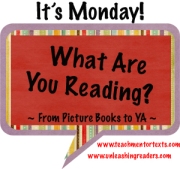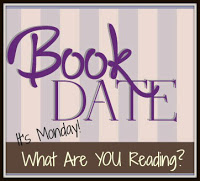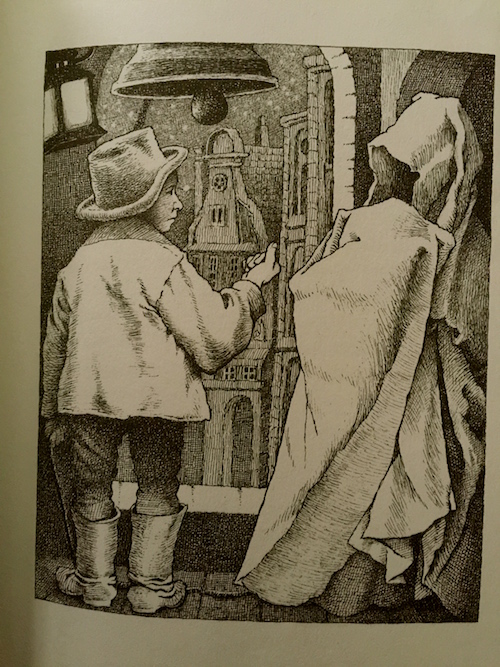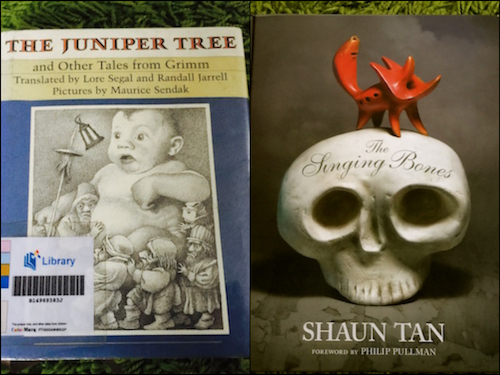

Myra here.
It’s Monday, What are You Reading is a meme hosted by Jen from Teach Mentor Texts and Kellee and Ricki from Unleashing Readers (new host of Monday reading: Kathryn T at Book Date). Since two of our friends, Linda from Teacher Dance and Tara from A Teaching Life have been joining this meme for quite awhile now, we thought of joining this warm and inviting community.
Last Week’s Review and Miscellany Posts

I read these two books a few weeks back, one after the other – and they gave me nightmares. Literally. I have always known that the original fairy tales are dark and grim – but it’s a different reading experience with the tales illuminated by Sendak’s deceptively-tender but downright-eerie images and Shaun Tan’s sculptures – they are indeed the perfect recipe for a very disturbing sleep.

The Juniper Tree And Other Tales From Grimm
Translated by: Lore Segal and Randall Jarrell
Pictures by: Maurice Sendak
Publisher: Farrar, Straus, and Giroux, 1973
Borrowed through inter-library loan. Book photos taken by me.
I am not sure anymore where I found out about this collection of fairy tales illustrated by Maurice Sendak. Usual suspect would be Brainpickings.org but I think my source for this one would be one of the many PD texts I have been reading in connection with my research project on multicultural picturebooks.
I was drawn to this collection primarily because the 27 tales are handpicked by Maurice Sendak himself (and illustrated by him) from the 210 tales in the Grimm collection. Sendak’s penchant for darkness and the subterranean layerings of children’s tales and the unconscious made him select the more sinister and quite a few lesser known stories of the Brothers Grimm.
While there are a few coming from fairy tales that most people are familiar with such as Rapunzel,

Snow-White and the Seven Dwarfs

Hansel and Gretel

the rest merely have resonances of stories that I may have read over the years. This book also found me at the precise moment when our journal manuscript is scheduled for publication in Bookbird: A Journal of International Children’s Literature where my co-researchers/good friends and I wrote about: “A Filipino Grandmother Grimm: Subversion of Foreign Fairy Tales through Indigenization and Cultural Appropriation in Mga Kuwento ni Lola Basyang (The Stories of Grandmother Basyang).”

And so there are parallels I noted between Grimm’s The Story Of One Who Set Out to Study Fear –

– and Pedrong Walang Takot (Fearless Pedro)

Both stories involved the presence of a sexton and boundless courage (that bordered on recklessness, almost).
There are also a few similarities between the Grimms’ Hans My Hedgehog –

– and Ang Prinsipeng Unggoy:

with parents who wish desperately to have children even if they look like hedgehogs or monkeys respectively.
In The Juniper Tree, the jacketflap also indicates what makes this particular collection of Grimm tales quite distinct:
The translations are another distinguishing quality of the Segal/Sendak edition. Both translators have been painstakingly faithful to the German texts; they have not cut, “retold,” or bowdlerized. In addition, Lore Segal and Randall Jarrell bring to their renderings of Grimm the grace and precision that are characteristic of their own original prose.
The stories are matter-of-fact and quite clinical in its rendering of blood and gore, death and mayhem, utter stupidity bordering on the absurd, and the inevitable comeuppance of evil people who (appear to) deserve such a bitter and grisly end. It was The Juniper Tree that disturbed me to no end – although I am a bit familiar with this having read My Mother She Killed Me, My Father He Ate Me: Forty New Fairy Tales edited by Kate Bernheimer back in 2011. Yet somehow this straightforward telling of the story in this collection sans drama left much more of an impact in my mind, enough to give me nightmares.

The Singing Bones
By: Shaun Tan Foreword by: Philip Pullman Introductory Essay by: Jack Zipes
Published by: Allen & Unwin, 2015
Book given to me as a gift by my husband.
I held this book in my hands prior to its being released in the international market while I was in Perth when my host brought me to The Literature Centre:

and I just know I need to have this book in my shelves. I am so glad that we already have it here in Kinokuniya and that I received this book as a gift from my husband for Christmas.
With a Foreword written by Philip Pullman and an Introduction by Jack Zipes, my academic heart was filled with glee. Pullman observed how he always wanted something more earthy, coarse, and grounded to represent fairy tales as opposed to the delicate, dainty, and elegant art of Arthur Rackham and his contemporaries – and that Shaun Tan was able to portray this and more through his sculptures:
… nothing I had imagined came close to the power and the strangeness, the sheer uncanny presence of the little sculptures Shaun Tan has created…
…The first thing I noticed was the strangeness they possessed. It had exactly the sort of distance from realism that I’d always wanted to see in fairy tale illustrations but had never found before.

The Frog King
Jack Zipes’ “How the Brothers Grimm Made Their Way Into the World” provided further context about fairy tales and their beginnings – and how they have evolved over the years. He also went on to examine in great detail the sculptures that Shaun Tan created as inspired by the raw, original stories of the Brothers Grimm:
All Tan’s sculptures estrange us and beckon us to gaze and think about moving them, to discover how they have been made, and why they have been drawn from the Grimms’ tales. They have been taken out of one world and installed in another setting. This is what the Grimms did with the tales they collected, and there is something like an elective affinity between Tan and the Brothers Grimm. Or perhaps I should say ‘electrical’ affinity, because Tan has transformed the Grimms’ tales into miraculous artworks that will move and speak for themselves.

The Singing Bone
Each of the plates consist of just a few lines that provide the basic essence of each fairy tale – yet the sculptures do not necessarily just reflect the selected passage but the entirety of the story. An Annotated Index can be found in the end to provide more details about each of the 75 stories. As I was going through each of the ‘plates’ – I was amazed at not only the solidness of the images but the entire setting, the whole frame of reference that brings the reader to a different life, a different time; one that is filled with walking shadows and the rustlings of stones that know betrayal and murder and treachery. I remember waking up my husband in the middle of the night, just asking him how all the elements go together – see the image below which really made me marvel at the craftsmanship in how everything was depicted with a transient solidity, transitory yet grounded, fleeting yet robust – it is like capturing clouds and eating them like meat for nourishment.

There is also the hint of gore, the suggestion of tragic endings, made all the more powerful by its subtlety and stolid, coarse, and crude representations: see image below which made me gasp aloud:

See the spatters of blood in an otherwise drab and monochromatic sculpture?
This is the stuff of Grimms’ fairy tales in all their unadorned embodiment of good, evil, and the in-between – breathed back into life, given form and space, effectively carving a crevice in your shadowy dreams by the unparalleled Shaun Tan.
A Juxtaposition of Maurice Sendak and Shaun Tan Renderings of Grimm
Mrs Gertrude in The Juniper Tales and Mother Trudy in The Singing Bones – the same creature who turned a young girl into a log to warm her at night.
The Devil with the Three Golden Hairs (Tan) or The Devil And His Three Golden Hairs (Sendak) which featured the Devil’s own grandmother – you see what Sendak did in this image here? Very Pieta-like almost in its glorious irreverence.
Fitcher’s Feathered Bird (Sendak) and Fitcher’s Bird (Tan) which featured a Bluebeard-like character (a murderous sorcerer) and how a girl escaped her inevitable doom with feathers.
Godfather Death – who to better choose as your child’s godfather, indeed? And my absolute favourite:


I liked Sendak’s translation of the ditty way better:
My mother she butchered me,
My father he ate me,
My sister, little Ann Marie,
She gathered up the bones of me
And tied them in a silken cloth
To lay under the juniper.
Tweet, twee, what a pretty bird am I!
Currently Reading…
I am glad to share that I did finish reading Cinder by Marissa Meyer last week and will schedule it for review sometime next month.

I am still reading All The Light We Cannot See by Anthony Doerr which is a slow-going kind of novel, so this might take quite awhile here.

I am also reading Lumberjanes, Volume 1: Beware the Kitten Holy by Noelle Stevenson, Grace Ellis, Brooke A. Allen , and Maarta Laiho.





















I am looking forward to reading Cinder this year and the ones that follow.I haven’t read the Doerr book and my sister gave up on it so… not thinking of it in the near or far future!
LikeLiked by 1 person
Your posts are always so detailed. I love the Grimm fairytales collection – looks dark and creepy, and I like how it’s not just the regular fairytales that it shows.
It’s Monday! What Are You Reading?
LikeLike
I’m inclined to think that the original fairy tales by the Grimm brothers were not meant for children at all. 🙂 I want to read Cinder some time this year. I put it off too many times and my daughter insists I must read the trilogy; it’s that good.
LikeLike
I enjoyed your reviews of the Grimm books, Myra, yet I’m not sure that I want to read more. They are certainly creepy! I do wonder about the audience they were meant for, but I had a neighbor a long time ago from Norway & she shared that children were told scary stories to keep them disciplined and safe (like the troll stories so kids wouldn’t go out at night). She was very afraid of the dark! Thanks for the wonderful reviews!
LikeLike
I’ve always wanted to do a study of fairy tales. And when I go to the Philippines next month, I hope to be inspired by my culture.
LikeLike
Oh, I love the Sendak illustrations are wonderful. I’ve already read he complete tales, but i may still have to check these out!
LikeLike
I’ve never been a huge fairy tale fan, but the Sendak and Tan artwork in those books is so phenomenal I really would like to seek them out! (I adore Lumberjanes and hope you’re enjoying it too!)
LikeLike
I am fascinated by fairy tales and love the art of Sendak and Tan, but now I’m not sure I’m brave enough to tackle both of these books–definitely not at the same time!
LikeLike
Having grown up in the west, I thought I knew all about fairy tales – we are raised here on Hans Christian Andersen and the Brothers Grimm and all the classics. As an adult, though, I realized that the fairy tales I had learned as a child were so sanitized as to be hardly recognizable! We have become so afraid of upsetting or scaring or potentially “traumatizing” our children that we keep them far away from these traditional stories, which for many of us are actually a part of our culture and heritage. In reality, children are often drawn to these macabre stories – for example, one of the reasons Roald Dahl was always so beloved was the way in which he didn’t shy away from doing terrible things to his characters (usually the bad ones), which for children can actually be incredibly cathartic! Thank you for another detailed and engaging post, highly enjoyable as always!
LikeLike
I love your thoughtful posts, Myra – and the way you always weave together the significance of art and culture in literary representations. The Juniper Tree sounds perfectly horrifying, no wonder the book gave you nightmares!
LikeLike
I will be looking for Lumberjanes. That Shaun Tan book looks amazing.
LikeLike
Mira, I was hooked on this post upon the first mention of Jack Zipes. One summer a friend of mine and I left the beautiful West Coast and travel to Minneapolis to take a course with Jack. I can’t remember the official name of the course, we just called it critical literacy through fairytales. Learning how to unpack the stories with children has been one of the most powerful learning experiences. I’ve had to adapt some of it to work with younger students. I’m looking forward to reading your paper. Have you read any of Terry Pratchett work where he talks about fairytales? I’ve quoted him at this blog post here. http://dickenslibrary.blogspot.ca/2012/12/witches-abroad-by-terry-pratchett.html
LikeLiked by 1 person
You are lovely. I just adore everything about your posts. I know I said something similar last time, but I couldn’t help but comment again.
A girl in my book club is reading All The Light We Cannot See, and she said it is very slow, so you are not alone! Have a great week!
LikeLiked by 1 person
I like the original Grimm fairytales too. I’ll check it out! 🙂
LikeLike
I hope you are having a good reading week.
Elizabeth
Silver’s Reviews
My It’s Monday, What Are You Reading
LikeLike
Enjoy Lumberjanes–I loved it!
I love Grimm fairytales, so I definitely want to check out the Sendack illustrated ones.
Happy reading this week! 🙂
LikeLiked by 1 person
Pingback: Lisbeth Zwerger’s Fairy Tale Art – Gathering Books
Pingback: [Monday Reading] Love for Books and the Sound of Silence in NPR’s Best Picture Books of 2016 – Gathering Books
Pingback: #GB101020 [Monday Reading] List of Ten Monday Reading Posts – Gathering Books